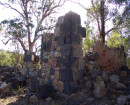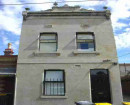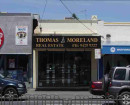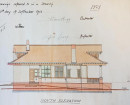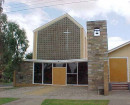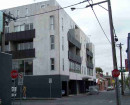Norwood Terrace
209-217 Auburn Road HAWTHORN, BOROONDARA CITY
-
Add to tour
You must log in to do that.
-
Share
-
Shortlist place
You must log in to do that.
- Download report
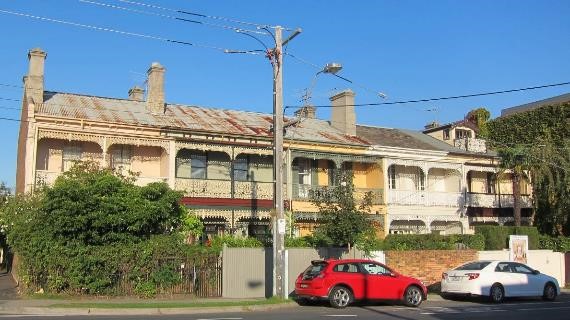

Statement of Significance
What is Significant?
Norwood Terrace, at 209-217 Auburn Road, Hawthorn, is significant. It is a two-storey Italianate terrace row of five two-storey attached dwellings, built in 1883-84 for owner Emily Morkham and rented to a variety of tenants.
The terraced houses are built of brick, with rendered front facades. The roof is a continuous transverse gable with parapeted end walls. Each house has a two-storey front verandah, all of which retain the original cast-iron detail. The houses retain rendered chimneys with a cornice to the front wings, some shared between houses some not, as well as corbelled face-brick chimneys to the lower rear wings. Only No. 215 retains its original slate roof cladding.
The terrace is significant to its 1880s fabric. Later alterations such as extensions to the rear, the dormers to No. 217, and the high brick front fences are not significant.
How is it significant?
Norwood Terrace is of local architectural significance and rarity value to the City of Boroondara.
Why is it significant?
As terraced houses, both rows and semi-detached pairs, are an uncommon building type in the City of Boroondara and most commonly seen in the western parts of Hawthorn and Kew, Norwood Terrace is one of a relatively small number of terrace-type houses in Boroondara, and one of the most easterly located examples. It is of even greater rarity as one of a very small number of terraced houses in Boroondara that were built prior to bylaws that required new attached dwellings to have party walls that extend above the roofs and front verandahs. With the change in regulations, the design of Italianate terraced houses changed, from front facades with exposed eaves to those finished with parapets. Norwood Terrace is one of a very small number of the earlier type, with exposed eaves. (Criterion B)
Norwood Terrace is a fine representative example of an Italianate terrace of the type that pre-dates the late 1880s boom. As such, it is simpler in its decorative detailing and use of render, and retains exposed bracketed eaves in keeping with Italianate villas of the 1870s and early 1880s. Other characteristic features of the Victorian Italianate are the rendered and corniced chimneys, front verandahs with cast-iron columns, balustrades and combined frieze and brackets, also six-panelled front doors with fielded panels and bolection mouldings (and original ruby-flashed lights at Nos. 211 and 215). (Criterion D)
-
-
Norwood Terrace - Physical Description 1
Norwood Terrace comprises a row of five attached two-storey dwellings in the Italianate style. They stand on the south-east corner of Auburn Road and Bowler Street. Each house has a medium-sized front setback, allowing for a modest front garden. The corner house, at No. 209, retains an original (or sympathetic reproduction) iron palisade fence and gate on bluestone footings.
A distinguishing feature of the terrace row is its transverse gable roof, which is parapeted at the ends. The roof form is continuous, being unbroken by party walls projecting above it. This configuration indicates its relatively early built date. While buildings within the City of Melbourne were subject to the Melbourne Building Act of 1849, which controlled building and subdivision standards, this was not the case for suburbs beyond its boundaries. It was not until the mid-1880s that suburban councils began to enact bylaws specifying building standards such as a requirement for new terraced dwellings to have party walls that extended above the main roof and verandah roof. The City of Richmond, for example, adopted building regulations requiring, among others, that conjoined houses must have an 'eight and a half-inch brick party wall' (The Argus, 12 June 1886, p.10). The result of these municipal bylaws created a clear distinction between terraces built before and after their enacting.
One of the roofs, at No. 215, retains what appear to be original slates, while the others have been reclad in corrugated iron. The dwellings at Nos. 209, 211 and 217 each have two rendered and corniced chimneys at their property boundary, while Nos. 213 and 215 share two larger chimneys with multiple flues. Each dwelling has a narrower two-storey rear wing, as was typical. The house at the north end of the terrace, No. 209, has a narrow rear wing to itself, set in from the side boundary, with a chimney on the south side of the hipped roof. The other four houses share double-width rear wings which sit below a shared pyramidal roof with a large chimney at the apex. All of the rear chimneys are of face brick with corbelled tops. The MMBW Detail Plan of 1903 (No. 1541) appears to show small single-storey sections at the rear of each wing. Most of them appear to have been replaced with later rear extensions. It is not clear if any of the rear dunnies, also visible on the MMBW plan, survive.
While the walls of the rear wings, as well as the parapeted north side wall of No. 209, are of Hawthorn face brick, in Colonial bond, the front facades are finished in ruled render like the chimneys to the front section.
In keeping with the modest Italianate style seen in the 1870s and early 1880s, the terrace has exposed front eaves with simple paired brackets, and restrained cast ornament to the faces of the verandah wing walls, including recessed panels, scrolled corbels, and a small cast lion's head to the north end of No. 209. The two-storey verandahs have a continuous skillion roof and a central cast-iron post with Corinthian capital at each level. All houses appear to retain their original cast-iron ornament, including combined frieze and brackets as well as balustrade panels (with a timber railing) to the first floor. Nos. 209 and 213 have identical cast-iron patterns, with a different balustrade pattern to No. 211. Nos. 215 and 217 share a suite of completely different patterns to the other three dwellings.
Behind the front verandahs, each house has the same configuration of a wide window with sidelights and a front door to the ground floor, and two full-length windows to the first floor. The front doors are six-panelled with fielded panels and bolection mouldings. Some of the sidelights and highlights appear to retain ruby-flashed glass (such as No. 211 and 215, as shown in real estate ads).
Nos. 209, 211 and 213 retain their original long double-hung sash windows to the first floor, while they have been replaced with French doors to Nos. 215 and 217. At ground-floor level, the sill of the sash window has been dropped to admit French doors, but the original sidelights have been retained. There is a similar configuration at No. 215, but it appears that the overall opening has been widened as well, so no original window elements remain. Finally, a dormer window with associated balcony and cast-iron fretwork has been added to the roof of No. 217 in the late twentieth century.
Heritage Study and Grading
Boroondara - Municipal-Wide Heritage Gap Study Volume 3: Hawthorn
Author: Context
Year: 2018
Grading: Significant
-
-
-
'ELAINE'
 Boroondara City
Boroondara City -
-oonah
 Yarra City
Yarra City -
..eld House
 Yarra City
Yarra City
-
-



